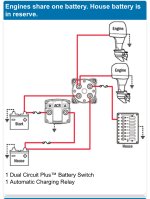ATPNW
Member
- Joined
- Jul 26, 2020
- Messages
- 85
- Reaction score
- 0
- C Dory Year
- 2006
- C Dory Model
- 23 Venture
- Vessel Name
- Fellowship
Current Setup
Use Case
Issue With Current Setup
Proposed Fix
Questions
- Twin Honda BF60’s
- Two Group 24 Dual Purpose Batteries
- Each motor has its own battery
- All accessories are spread between the two batteries
Use Case
- 90% of the time I am trolling for salmon, alternating every hour or so between each engine to try and keep the hours similar
- Other 10% of time engines are off jigging for bottom fish
Issue With Current Setup
- After port motor has sat for some time, and the starboard motor was running. If I start the port motor my electronics flicker. My autopilot is on the port motor and looses course when this happens and I have to reset everything.
Proposed Fix
- Install this battery switch (attached)and ACR. Making one battery my starting battery and the other a dedicated house.
- The big power draws on the house would be:
- Two Downriggers
- Wallas Heater
- Garmin 1243
- Garmin 943
- Garmin VHF
- The big power draws on the house would be:
Questions
- For my use case is this a sufficient setup?
- What might I not be considering with this setup?

